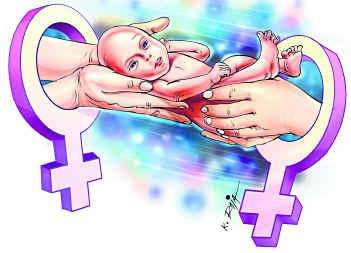The Dark Side of Third-Party Reproduction
 Public Discourse 3 August 2015
Public Discourse 3 August 2015
I’m sure you’ve seen them in the media: attractive, well-off, smiling parents holding adorable infants created by third-party reproduction and assisted reproductive technologies (ART). Of course, the narrative goes, this development is a win-win for all. Who could object to children being created for those who through either infertility or biological sex are unable to reproduce?
But this picture hides the highly profitable fertility industry’s dirty secrets. It ignores what is required to create these children: exploitation, health endangerment, and the commodification of human life. An honest look at the facts and circumstances surrounding third-party reproduction and ART should give any thinking person pause.
The Exploitative Consequences of Egg Harvesting and Surrogacy
Third-party reproduction first of all requires the procurement of gametes, a man’s sperm and a woman’s egg. The egg is artificially inseminated, and a woman must gestate and give birth to the resulting embryo or embryos. What, in terms of chemicals and technology, is involved in obtaining the necessary human gametes? Here, biology is not exactly fair. While sperm is obtainable through the straightforward process of male ejaculation, it’s a radically different situation to obtain eggs. The egg provider must undergo weeks of painful self-injections of carcinogenic synthetic hormones and other drugs followed by surgery for egg retrieval.
Real People, Real Lives at Risk
It is important in any discussion of these issues not to get lost in abstraction. The new documentary Eggsploitation: Maggie’s Story, produced by the Center for Bioethics and Culture, provides a very up-close-and-personal view of what actual women are subjected to by fertility clinics and the tragic consequences that can follow egg selling.
Little Oversight or Care
How can this happen? The answer is quite simple: There is virtually no regulation of the fertility industry in the United States. For this reason, it has become a popular destination for international fertility “tourism.” The American Society for Reproductive Medicine (ASRM) and the Society for Assisted Reproductive Technologies (SART) issue recommendations that are strictly voluntary and therefore unenforceable. For example, they advise that women undergo no more than six stimulated cycles, yet Maggie underwent ten.
Biological Bonds Matter
In her book Origins: How the Nine Months Before Birth Shape the Rest of Our Lives, Annie Murphy Paul documents the emerging field of fetal origins. Over the last twenty years, scientists have improved our understanding of how experiences in utero exert lasting effects from infancy through adulthood. The research reveals that pregnancy is a crucial staging ground for our life-long health, ability, and well-being. For instance, individuals gestated during the Nazi siege of Holland in World War II continued to feel its consequences decades later. As a result of both the siege and a severe winter that resulted in famine, studies demonstrated that people whose mothers were pregnant then have higher rates of diabetes, obesity, and heart disease later in life. Their exposure to insufficient nutrition in the womb appears to have had long-lasting effects on their health. In addition, a study published in the Journal of the American Medical Association in 2005 showed that people born to women during the famine were twice as likely to develop schizophrenia. It has been found that severe maternal malnutrition can be a contributing factor in the development of schizophrenia.
http://www.thepublicdiscourse.com/2015/08/15413/?utm_source=The+Witherspoon+Institute&utm_campaign=eab1e2e7cd-RSS_EMAIL_CAMPAIGN&utm_medium=email&utm_term=0_15ce6af37b-eab1e2e7cd-84094405






